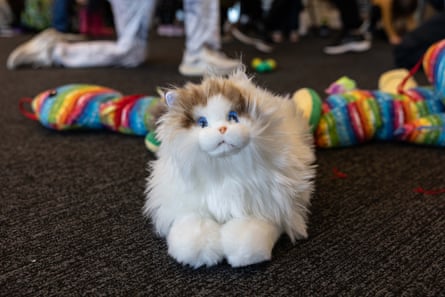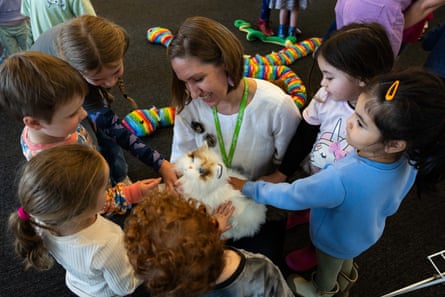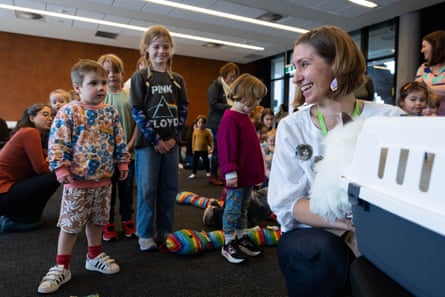At Springwood library in the Blue Mountains, a librarian appears with a cat carrier in each hand.
About 30 children gather around in a semicircle. Inside each carrier, a pair of beaming, sci-fi-like eyes peer out at the expectant crowd.
“That is the funniest thing ever,” one child says.
The preschoolers have just finished reading The Truck Cat by Deborah Frenkel and Danny Snell for the annual National Simultaneous Storytime.
The MetaCats, two therapeutic robotic pets, are special guests at the reading, on a maiden tour of libraries across the Blue Mountains in New South Wales.
The Blue Mountains city council says the lifesize and weighted feline replicas can provide comfort and reduce stress – especially for children or people living with anxiety or dementia.

The MetaCats can miaow and purr. They have animated LED eyes, soft non-allergenic fur and silicone paws. Yes, an artificial heartbeat thumps away inside.
With inbuilt head, chin and back sensors, the cats respond to human touch, and they interact with realistic movements to certain voice commands.
When someone says “I love you MetaCat”, their eyes light up with glowing heart symbols.
Ewan, three, can’t get enough of the black cat. He giggles and squeals with glee each time its head swivels towards him.
“He’s obsessed,” laughs Amy Cameron, Ewan’s mother. She thinks it’s because it resembles their own family cat, Diego.
Meanwhile, Stella, 10, is smitten with the white cat’s fur, declaring it “feels real”. Her six-year-old brother, Charlie, reminisces about Snufflepuss, their elderly orange cat who recently died.

Dr Rosemary Dillon, CEO of the Blue Mountains city council, says the council decided to buy the MetaCats for the community after spotting them at the 2024 NSW Public Libraries Association conference.
Dillon says one library manager told her visitors had started speaking to their library MetaCat, perched above the circulation desk, more than they did with the human staff.
The MetaCats have proven unexpectedly popular with older residents, Dillon says. “A high percentage of older people … live alone in the Blue Mountains and they come to the library for company,” she says. “This will be another layer of interaction for them.”
Loneliness is a pressing national public health concern: one in four Australians report feeling persistently lonely, according to a recent study.
Associate professor Alyssa Milton, a children’s mental health expert from the University of Sydney, says MetaCats may offer relaxed and predictable connections for people.
“Robot pets, or real-life pets, can help children feel safe and seen,” she says. “Robotic animals do show some early promise in the research literature on supporting children experiencing differences in neurological development.”

Milton says libraries and community spaces can help alleviate feelings of social disconnection, and the MetaCats offer an alternative for families who face housing or allergy barriers to owning a real cat or dog.
Judging by the reactions in Springwood, MetaCats are a hit.
The children line up eagerly to meet the furry animatrons.
Stella and Charlie’s mother, Stephanie Lambiris, says the family made a special trip to Springwood to meet the cats. “It’s gentle, it’s sweet,” she says.
Name suggestions for the pair are welcome via “cat-flap” nomination boxes at library branches until 7 June. Stella submitted Snufflepuss, of course.
Prof Adam Guastella, an expert in child neurodevelopment at the University of Sydney, says robotic animals can support learning and social skills.
“Early studies have shown … robotic dogs can improve social communication in autistic children,” Guastella says.

Dr Nathan Caruana, a cognitive psychology lecturer at Flinders University, agrees the idea holds promise.
He has led research on social robots supporting children with reading difficulties and emotional challenges.
“Children crave attention – and feeling like there’s a bit of a spotlight on them that isn’t judgmental can be really motivating” he says.
However, Caruana says his research is ongoing and evidence for using robots as a mental health tool is still evolving.
After this tour, the mechanical duo will move to what the council describes as their “fur-ever” homes, the Springwood and Katoomba libraries, though they will travel to other libraries for special events.

 3 months ago
104
3 months ago
104

















































